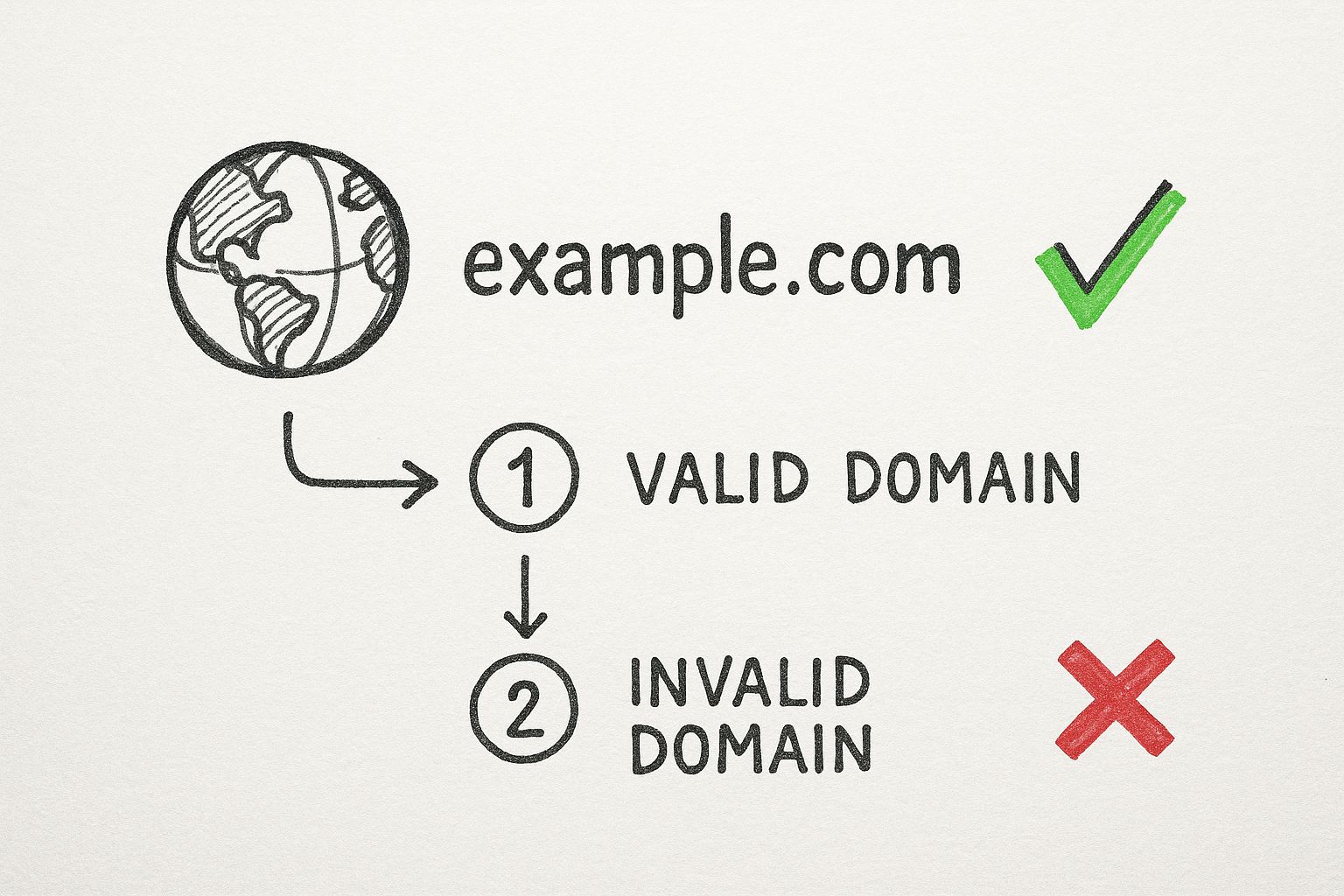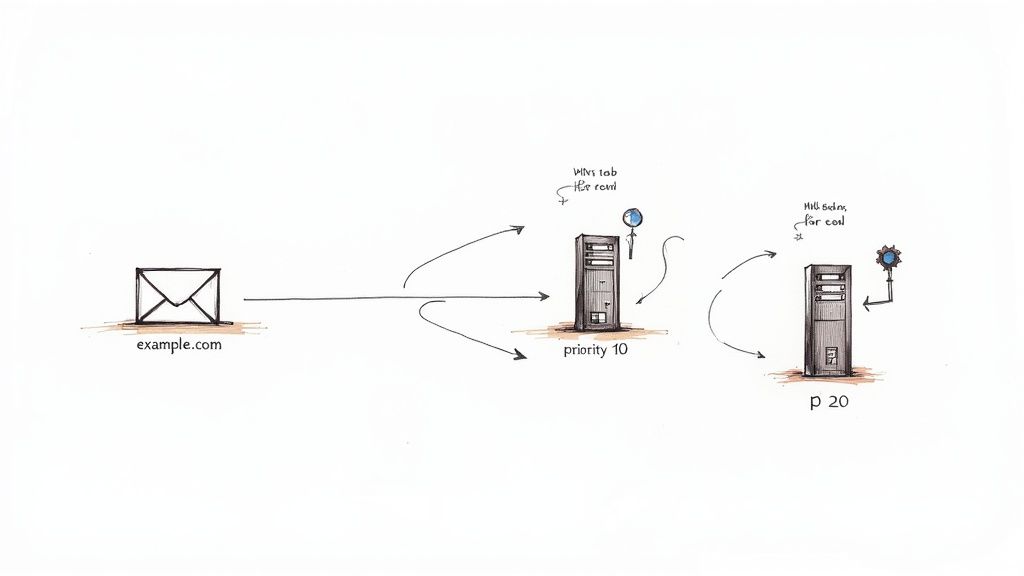It’s tempting to think a high bounce rate is just a minor annoyance, but let's be real—it’s a symptom of a much bigger problem. You absolutely must validate if an email exists to protect your sender reputation and avoid throwing your marketing budget down the drain. Every bounce signals to providers like Gmail that you might be a spammer, which can torpedo your deliverability and land even your valid emails in the spam folder.
Why You Must Validate Your Email Lists

Focusing only on bounces misses the forest for the trees. A "dirty" email list, cluttered with typos and non-existent addresses, causes real, lasting damage. Each invalid email you send chips away at your sender reputation—a critical score that mailbox providers use to decide if you’re trustworthy. Once that reputation tanks, your carefully crafted campaigns get filtered straight to spam, never to be seen by your audience.
I saw this firsthand with an e-commerce client. Their campaign ROI took a nosedive, seemingly out of nowhere. After digging in, we found the culprit: they'd imported a huge, unverified list from a trade show. The resulting bounce storm got their domain blacklisted. Suddenly, none of their emails were reaching customers, not even the loyal ones who were waiting for order confirmations.
The Hidden Costs of Bad Data
Beyond deliverability, there's a straight-up financial cost to sending emails into the void. Think about all the resources poured into a single campaign—the copywriting, the design, the strategic planning, not to mention your email platform fees. Sending to ghost addresses is like setting that money on fire.
And this problem is only getting bigger. By 2025, the global email user base is projected to hit a staggering 4.6 billion people. With many individuals juggling multiple accounts, the total number of active email addresses is estimated to be around 8.3 billion worldwide. That’s a massive pool of addresses, making it easier than ever for bad data to slip into your lists.
A dirty email list doesn't just waste money; it skews your analytics. When your open rates and click-through rates are based on a flawed list size, you can't make accurate strategic decisions, leading to a cycle of poor performance.
Protecting Your Campaign Performance
At the end of the day, clean data is the bedrock of any successful outreach effort. If you want to supercharge your campaigns, you have to feed them clean fuel. Even the most powerful email marketing automation tools are rendered useless if they’re working with a list full of duds.
Validating an email isn't just a technical box to check; it’s a non-negotiable part of a smart marketing strategy. It’s what gives your message a fighting chance to be seen, protects your brand, and delivers a clear, honest picture of how your campaigns are really performing. Without it, you’re just marketing in the dark.
Foundational Checks for Email Hygiene
Before you get fancy with verification tools, let's talk about the basics. Think of these as your first line of defense—a quick, manual scan to weed out the most obvious offenders and instantly improve your email hygiene. You don't need any special software for this, just a keen eye.
The most fundamental check is email syntax. A real email address has a specific structure: a local part, the "@" symbol, and a domain. It’s a simple formula, but you'd be surprised how many submissions break it.
A correctly formatted email looks like username@domain.com. I often see errors like a missing "@" symbol (e.g., user.domain.com) or characters that just don't belong, like spaces or multiple "@" signs. Catching these syntax mistakes is the easiest win in your validation process, stopping immediate bounces from mangled addresses.
Identifying Disposable Email Addresses
Beyond simple typos, you have to watch out for disposable email addresses. These are temporary, throwaway accounts from services like Mailinator or 10MinuteMail. While they are technically valid in their format, they usually signal low-intent or even fraudulent sign-ups.
Someone using a disposable address is probably just trying to grab a one-time offer without ever hearing from you again. Sending emails to these addresses is a total waste of resources. They're rarely monitored and often expire in minutes or hours. Learning to spot the domains associated with these services is a key step in filtering out contacts who have no real intention of engaging with you.
For a deeper look into the different layers of verification, you can check out our detailed guide on how to validate email addresses, which covers everything from these basic checks to more advanced server-level pings.
The Limitations of Manual Checks
While these initial scans are helpful, it’s critical to understand where they fall short. A syntactically correct email isn't necessarily an active one. An address like thisisprobablyfake@gmail.com passes the format test perfectly, but the mailbox itself might not exist.
Manual checks are an excellent starting point for basic list cleaning. They catch typos and obvious throwaway accounts but can't confirm if a correctly formatted email is actually active and able to receive messages.
This is why these foundational checks are just one piece of the puzzle. They help you clear out the low-hanging fruit—the blatant errors and temporary accounts. But they can’t protect you from the trickier issues, like a validly formatted email at a real company that was deactivated months ago when an employee left. To catch those, you'll need to move on to more robust methods.
How SMTP Probing Verifies an Address
Once you’ve weeded out the addresses with obvious typos, the next layer of verification gets a bit more technical. It's a method called SMTP probing, and you can think of it like knocking on a mail server's door to ask if a specific person lives there—all without actually sending a letter. It's a direct, real-time conversation with the recipient's email server.
This process essentially mimics the first few steps of sending an actual email. Your system initiates a kind of digital handshake with the mail server using the Simple Mail Transfer Protocol (SMTP). This "conversation" is just a quick series of commands designed to confirm one thing: does this mailbox exist?
The SMTP Handshake Explained
The entire back-and-forth is over in seconds. It's a clean, content-free exchange that's all about querying, not delivering.
Here’s a simplified breakdown of how it works:
- HELO: Your system starts by introducing itself to the server, like saying, "Hello, I'm here to talk."
- MAIL FROM: Next, it specifies the sender's address, essentially telling the server, "This query is coming from this address."
- RCPT TO: This is the moment of truth. Your system asks the server, "Do you have a mailbox for
prospect@example.com?"
The server’s response to that final RCPT TO command tells you everything you need to know. If the server replies with an "OK," the address is good to go. If it sends back an error like "No such user here," you know the address is invalid. For a deeper dive into how this fits into a complete verification strategy, our guide on how to check if an email address exists puts all the pieces together.
The infographic below shows how a system can quickly validate a domain's legitimacy before it even starts checking individual addresses.

As the visual shows, confirming the domain is a critical first step. After all, if the domain isn't set up to receive mail, no email address associated with it will ever work.
The Risks and Limitations
While SMTP probing is incredibly accurate, it's not something you should try to DIY. Many modern email servers are savvy to this kind of activity and are configured to block it. They might see repeated pings from a single IP address as a reconnaissance mission for a spam attack.
Critical Warning: Attempting manual SMTP probing can easily get your IP address blacklisted by major email providers. This will tank your sender reputation and could get all your emails blocked—not just the verification pings.
This is precisely why SMTP probing is best left to professional validation services. Platforms like PlusVibe run these checks from a distributed network of servers, spreading the requests out to avoid raising red flags. It gives you the pinpoint accuracy of a direct server check without putting your entire sending infrastructure at risk. It’s the behind-the-scenes magic that makes reliable, real-time email verification possible.
Using Email Validation APIs for Real-Time Accuracy
While manual checks and even SMTP probing have their uses, the real game-changer for any serious business is the email validation API. Think of an API (Application Programming Interface) as a direct line between your software and a specialized validation service. It allows your systems to ask a simple, crucial question in real-time: "Is this email legit?"
This is hands-down the most reliable and scalable way to keep your email list clean. It's not just about tidying up a list you already have—it's about stopping bad data from ever polluting your database in the first place.
Picture this: a potential customer is signing up for your newsletter. The second they hit "submit," your form uses the API to check the address. In less than a second, the API fires back a response. This allows you to instantly reject a fake or misspelled email and ask the user to fix it. This immediate feedback is a lifesaver for maintaining data quality from day one.
Making Sense of API Responses
When you use a quality email validation API, you don't just get a simple "yes" or "no." You get a detailed breakdown that helps you make smarter decisions on the fly. Getting a handle on these responses is fundamental to managing your list like a pro.
Here are the usual suspects you'll see:
- Valid: This is the green light. The API has confirmed the email syntax is correct and the mailbox is active and ready to receive mail. Add them to your list.
- Invalid: A hard no. The address is either badly formatted or the server has confirmed the mailbox flat-out doesn't exist. These should be blocked at the door.
- Catch-All: This one's tricky. The server is set up to accept all emails sent to its domain, so you can't be sure if the specific inbox is real. Sending to these is a gamble.
- Unknown: The server was cagey and didn't give a clear answer. This can happen for all sorts of reasons, from temporary glitches to tough security settings.
How you handle these statuses is the bedrock of good list hygiene. For instance, a smart strategy is to accept 'Valid' emails, flag 'Catch-All' and 'Unknown' for a closer look, and block 'Invalid' contacts right at the point of entry.
Picking the Right API for the Job
Not all APIs are built the same. When you're shopping around, look for a provider that uses a multi-layered approach—one that combines basic syntax checks with deep SMTP analysis and domain health inspections. For a full rundown of what a top-tier service should deliver, our guide on email verification covers all the must-have features.
The technology is also getting smarter. By 2025, AI-powered algorithms are set to become a standard feature, massively boosting the accuracy of these tools. This is a big deal, especially when you consider that inbox placement rates can swing wildly by region, from around 91% in Europe to as low as 78% in the Asia-Pacific. You can learn more about where things are headed from these future email validation trends and predictions on Bouncify.io.
At the end of the day, plugging in a quality API isn't a cost—it's a proactive investment. It safeguards your sender reputation, makes sure your messages land in front of real people, and gives you the clean, reliable data you need to make your marketing count.
Pairing Validation with Email Authentication
 Knowing how to validate if an email exists is a massive step toward better deliverability, but it’s only one side of the coin. The other, equally critical side is email authentication.
Knowing how to validate if an email exists is a massive step toward better deliverability, but it’s only one side of the coin. The other, equally critical side is email authentication.
Think of it this way: validation confirms who you’re sending to, while authentication proves who you are.
Without both, your messages are flying blind. Major mailbox providers like Gmail and Yahoo now have strict authentication requirements. If you can't prove your identity as a legitimate sender, your carefully validated emails won't even get a chance to land in the inbox.
This is where protocols like SPF, DKIM, and DMARC come into play. They act as your digital ID card, telling servers that your emails are genuinely from you and not from a spoofer or phisher trying to impersonate your brand.
Building Trust with Recipient Servers
Imagine trying to get into an exclusive club. Email validation is like having your name on the guest list—it proves the person exists. Email authentication is like showing your ID to prove you’re actually the person on that list. You absolutely need both to get past the velvet rope.
When you pair a squeaky-clean, validated list with a fully authenticated sending domain, you create a powerful one-two punch for deliverability. This dual strategy builds immense trust with recipient servers, which are constantly on the lookout for red flags.
A validated list shows you respect the recipient's system by not sending junk to dead-end addresses. An authenticated domain shows you respect their security by proving you are who you claim to be. Together, they signal you're a high-quality sender.
The Rise of Authentication Standards
The importance of this combination is growing, and fast. The global adoption of DMARC, a key authentication standard, has seen a sharp increase. In 2024, nearly 54% of organizations implemented DMARC, a big jump from less than 43% in 2023.
While DMARC itself doesn’t validate if an email exists, its widespread use shows just how critical sender identity has become. You can discover more insights about these deliverability trends on Mailgun.com.
Combining these robust authentication methods with a reliable verification service is the ultimate strategy. For businesses looking to scale their outreach without getting blacklisted, integrating these practices is no longer optional—it's essential. Services with built-in checks, like those in PlusVibe's platform, make this whole process much simpler. To see how these tools fit into a larger strategy, explore our guide to choosing the right email validation software.
Of course. Here is the rewritten section, designed to sound completely human-written and natural, following all your specified requirements.
Common Questions About Email Validation
Even when you have a solid plan, a few specific questions always seem to come up once you get your hands dirty with email validation. It happens to everyone. Let's tackle some of the most common ones I hear, so you can clean your lists with total confidence.
Getting these details right can transform your general knowledge into a precise, effective strategy that actually works.
What's the Deal with "Catch-All" Emails? Should I Bother Sending to Them?
A "catch-all" is basically a server setting that says, "Yep, I'll take it!" to any email sent to its domain, even if the address itself (like definitely.not.real@domain.com) doesn't technically exist. Because of this, sending to them feels like a bit of a gamble.
Sure, the email won't hard bounce, which is good. But the bad news is there’s no guarantee a real person is on the other end. In my experience, many of these are either totally unmonitored or, worse, set up as spam traps, which will slowly but surely tank your sender reputation.
The smartest move is to segment catch-all addresses out of your primary campaigns. Treat them as a risky, low-priority group. This protects the deliverability of your most important outreach and keeps your main list healthy.
How Often Should I Be Validating My Email List?
This really comes down to how you're collecting emails in the first place. If you have a form on your website pulling in new contacts all day, you absolutely need a real-time API to check them the second they're entered. No exceptions.
For your existing lists, a good rhythm to get into is re-validating them every 3-6 months. Data decay is a real and constant problem—people change jobs, ditch old email accounts, and hop between providers all the time. Staying on top of this with regular cleanups is the key to maintaining a healthy sender score and preventing your deliverability from slowly sinking. To see how this fits into the bigger picture, you can learn about email warm-up for new domains and why it's so important.
Can Any Service Really Guarantee 100% Validation Accuracy?
Nope. And you should be wary of any service that claims it can. The email world is just too dynamic, and some mail servers are deliberately set up to be vague during an SMTP check. They won't give a clear "yes" or "no," which is what leads to that frustrating "unknown" status.
But a top-tier service can get you to 98-99% accuracy. Honestly, that's more than enough to crush your bounce rate, safeguard your sender reputation, and make sure your messages are actually getting seen. The goal isn't impossible perfection—it's just smart risk management.
Ready to stop guessing and start connecting with real customers? PlusVibe uses advanced AI-powered validation to ensure your emails reach the right inbox every time. Clean your list and boost your deliverability today.














































.jpeg)


.png)























































